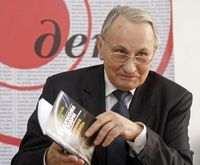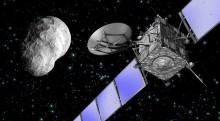Comet 67P/Churyumov-Gerasimenko was discovered by professor of Kyiv University Klim Churyumov and researcher of the Institute of Astrophysics at the Academy of Sciences of Tajikistan Svetlana Gerasimenko in 1969.
Comets are often called celestial travelers. This is due to the characteristics of their orbits. They go into the depths of the universe for many years, and then come back with slightly changed parameters of their movements. Scientists have taken special interest in celestial travelers due to the fact that they consist of material that originated shortly after the so-called Big Bang, which formed stars and planets.
Astronomers and astrobiologists have long put forward the hypothesis that comets are giant clumps of cosmic dust, carbon dioxide ice and water ice, containing also chemical compounds that were present in the early stages of formation of our solar system. There is an assumption that it is the comets that spread life across the Universe. Interestingly, Churyumov-Gerasimenko never comes too close to the Sun. Therefore, it has been preserved in relatively pristine condition.
The European Space Agency (ESA) has developed and implemented the project, aiming to launch a space probe Rosetta to study the comet. About 10 years ago, it was planned to send the spacecraft to comet 46P/Wirtanen, but the start had to be postponed because of problems with the reliability of heavy carrier rocket Ariane 5. It was finally redirected to comet 67P/Churyumov-Gerasimenko. Interestingly, the scientists who discovered the comet were personally present at the launch of Ariane 5 at Kourou spaceport (French Guiana) on March 2, 2004.
As the Rosetta project specialist Matt Taylor told the press at a briefing at the European Space Operations Center in Darmstadt, “Comets have fascinated researchers because of their unpredictability. One such surprise was a recent outburst of 67P’s activity, although at the time the spacecraft was fortunately still too distant to be damaged by it. As it approached the comet, we did a series of measurements, detecting molecules of frozen water, carbon monoxide, carbon dioxide, methane, nitrogen, and sulfur. The probe caught dust particles and measured their speed.”
Researching the substances that make up most of the comets is very important for understanding the stages and directions of the universe’s development. This knowledge will help answer many questions about our planet as well.
To accelerate the Rosetta carrier spacecraft to the desired speed, the ESA plotted a difficult route that used gravity forces of Earth and Mars as acceleration components. Long travel time to the comet and difficult route were required because the humankind has not created yet a launch vehicle powerful enough to bring the spaceship directly to the object. Rosetta flew past Earth three times and past Mars once, and met asteroids Lutetia and Steins in the main asteroid belt, located between Mars and Jupiter.
Rosetta carried lander Philae, which did a series of studies while still on its way to the comet. In particular, it mapped the object and received high resolution pictures of the comet. The surface work will include studying chemical and isotopic composition of the comet’s nucleus. Philae’s equipment weighs 21 kilograms and includes 10 instruments, such as a mass spectrometer, a gas chromatograph, pyrolyzers, and a camera.
Rosetta approached the ultimate goal of its journey in early 2014. To keep boarding and orientation safe from the effects of the comet’s tail, the luminous stream that appears in the comet as it approaches the Sun, Rosetta approached the object long before its approach to our star.
Landing on a comet differs from a similar operation as done on Earth, the Moon or Mars. It is practically the same as docking of one spaceship to another. This is due to the small size of comets and low gravity conditions on their surface. To avoid the spacecraft bouncing from the object, its speed was just 2.5 kilometer per hour. The landing procedure lasted for over seven hours. As long as the lander will operate on the surface of the nucleus of the comet, Rosetta will stay close to it in the space and act as a relay radio station. When Philae was safely anchored on the surface of a comet, the signal was received on Earth with a delay of 26 minutes required to overcome the transmission distance of 6 billion kilometers.
Even as it approached the comet, Rosetta heard the so-called song of Churyumov-Gerasimenko comet. The “sound” that is so interesting for scientists was recorded by measuring the magnetic field near the comet, which was done by the spacecraft’s instruments. This magnetic field oscillates at frequencies of 40 to 50 MHz, which are not perceived by the human ear. The lower limit of the perception of sound by the human ear is about 6 Hz.
To convert magnetic oscillations of a comet into a sound, the scientists artificially increased the frequency by a factor of 1,000. These oscillations were detected for the first time in August, when the spacecraft was 100 kilometers from the comet. According to scientists, it may be generated by neutral particles emitted from the surface and charged by the process of ionization. However, the exact cause remains unclear. As noted by one of the mission’s participants Karl-Heinz Glassmeier, “it is exciting because it is completely new to us. We were not expecting this and are still trying to understand the physics of what is happening.”
According to the NASA, the first pictures of the surface of the comet nucleus have been received and the analysis of the chemical composition of the substances of which it is composed has been done. As the ESA follows a strict policy aimed to limit distribution of their photos, no picture of the comet has been officially released so far. Characteristically, the well-known popular science website Universe Today published the first photo allegedly taken by the Philae probe on the surface of Churyumov-Gerasimenko, but soon removed it along with the link. It may well be they did it on the ESA’s request.
After landing the research unit, Rosetta spacecraft will move along with the comet. It will come nearest to the Sun on August 13, 2015, after which time the comet will fly away, deep into the outer reaches of our solar system. The mission is scheduled to finish on December 31, 2015. However, the ESA’s top representative in Russia Rene Pichel said that the work might be continued after that date.
“The whole world pays its respects to the Kyiv astronomers who discovered this comet”
Yaroslav YATSKIV, director of the Main Astronomical Observatory of the National Academy of Sciences (NAS) of Ukraine, Academician of the NAS of Ukraine:
 “Ukrainian scientists were very lucky to discover this comet and we got lucky again lately, as Rosetta was developed to visit another comet, but certain changes in the situation made its creators to chose comet Churyumov-Gerasimenko instead, and we are very proud of this.
“Ukrainian scientists were very lucky to discover this comet and we got lucky again lately, as Rosetta was developed to visit another comet, but certain changes in the situation made its creators to chose comet Churyumov-Gerasimenko instead, and we are very proud of this.
“These two Kyiv researchers are both students of Sergei Vsekhsvyatsky, professor of Kyiv University and a world-renowned comet researcher. Of course, they made their discovery in the Soviet time, and they may certainly be considered Soviet scientists, but they are now on the faculty of Kyiv University, and Churyumov is a member of the Ukrainian Academy of Sciences. They discovered this comet based on observations done in Central Asia. Under the auspices of Vsekhsvyatsky, the comet team members, as we called them, were then actively traveling to various observatories and doing photographic observations, discovering new comets. The comet was discovered in this way, using observations of Gerasimenko and Churyumov. They saw that a new comet was detected when they looked at the film the day following their observations.
“Landing a research unit on the comet’s nucleus is a fantastic feat of space science and technology. Unfortunately, Ukraine did not really take part in providing instruments for this mission, but Churyumov and Gerasimenko were present throughout all stages of launching this historic space mission from Kourou spaceport. That is, the whole world pays its respects to the Kyiv astronomers who discovered this comet.”
Interviewed by Olha KHARCHENKO, The Day








